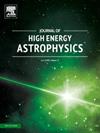Strong gravitational lensing by rotating quantum-corrected black holes: Insights and constraints from EHT observations of M87* and Sgr A*
IF 10.2
4区 物理与天体物理
Q1 ASTRONOMY & ASTROPHYSICS
引用次数: 0
Abstract
We study gravitational lensing in the strong-field limit using the rotating quantum-corrected black hole (RQCBH) with an additional parameter α besides mass M and spin parameter a. We discover a decrease in the deflection angle , the photon sphere radius , and the angular position . The flux ratio of the first image to all subsequent images, , decreases rapidly as α increases. We compare RQCBH observables with those of Kerr black holes, using Sgr A* and M87* as lenses to observe the effect of the quantum-corrected parameter α. For Sgr A*, the angular position in , while for M87* . The angular separation s, for supermassive black holes (SMBHs) SgrA* and M87*, differs significantly, with values ranging for Sgr A* and for M87*. The deviations of the lensing observables and for RQCBH () from Kerr black holes can reach up to and for Sgr A*, and and for M87*. The relative magnitude . We also compared the time delays between the relativistic images in the 22 SMBHs at the center of various galaxies. We found that RQCBH can be quantitatively distinguished from Kerr black holes. Interestingly, the time delay for Sgr A* and M87* can reach approximately 6.0127 min and 308.15 hrs, respectively. Our analysis concludes that, within the 1σ region, a significant portion of the parameter space agrees with the EHT results of M87* and Sgr A*.
旋转量子校正黑洞的强引力透镜:从对M87*和Sgr A*的EHT观测中获得的启示和约束
我们利用旋转量子校正黑洞(RQCBH)研究了强场极限下的引力透镜现象,该黑洞除了质量M和自旋参数a之外还多了一个参数α。随着 α 的增大,第一幅图像与所有后续图像的通量比 rmag 会迅速减小。我们以 Sgr A* 和 M87* 为透镜,比较了 RQCBH 与克尔黑洞的观测值,以观察量子校正参数 α 的影响。超大质量黑洞SgrA*和M87*的角位相距s差别很大,Sgr A*的角位相距s∈(0.033-0.79)μas,M87*的角位相距s∈(0.033-0.59)μas。RQCBH (a=0.8,α=0.4)与克尔黑洞的透镜观测值|Δθ∞|和|Δs|的偏差对Sgr A*可达1.6μas和0.41μas,对M87*可达1.2μas和0.31μas。相对震级rmag∈(1.81-6.82)μas。我们还比较了位于不同星系中心的 22 个 SMBH 的相对论图像之间的时间延迟。我们发现,RQCBH 可以与克尔黑洞进行定量区分。有趣的是,Sgr A*和M87*的时间延迟分别达到了约6.0127分钟和308.15小时。我们的分析结论是,在1σ区域内,参数空间的很大一部分与M87*和Sgr A*的EHT结果一致。
本文章由计算机程序翻译,如有差异,请以英文原文为准。
求助全文
约1分钟内获得全文
求助全文
来源期刊

Journal of High Energy Astrophysics
Earth and Planetary Sciences-Space and Planetary Science
CiteScore
9.70
自引率
5.30%
发文量
38
审稿时长
65 days
期刊介绍:
The journal welcomes manuscripts on theoretical models, simulations, and observations of highly energetic astrophysical objects both in our Galaxy and beyond. Among those, black holes at all scales, neutron stars, pulsars and their nebula, binaries, novae and supernovae, their remnants, active galaxies, and clusters are just a few examples. The journal will consider research across the whole electromagnetic spectrum, as well as research using various messengers, such as gravitational waves or neutrinos. Effects of high-energy phenomena on cosmology and star-formation, results from dedicated surveys expanding the knowledge of extreme environments, and astrophysical implications of dark matter are also welcomed topics.
 求助内容:
求助内容: 应助结果提醒方式:
应助结果提醒方式:


